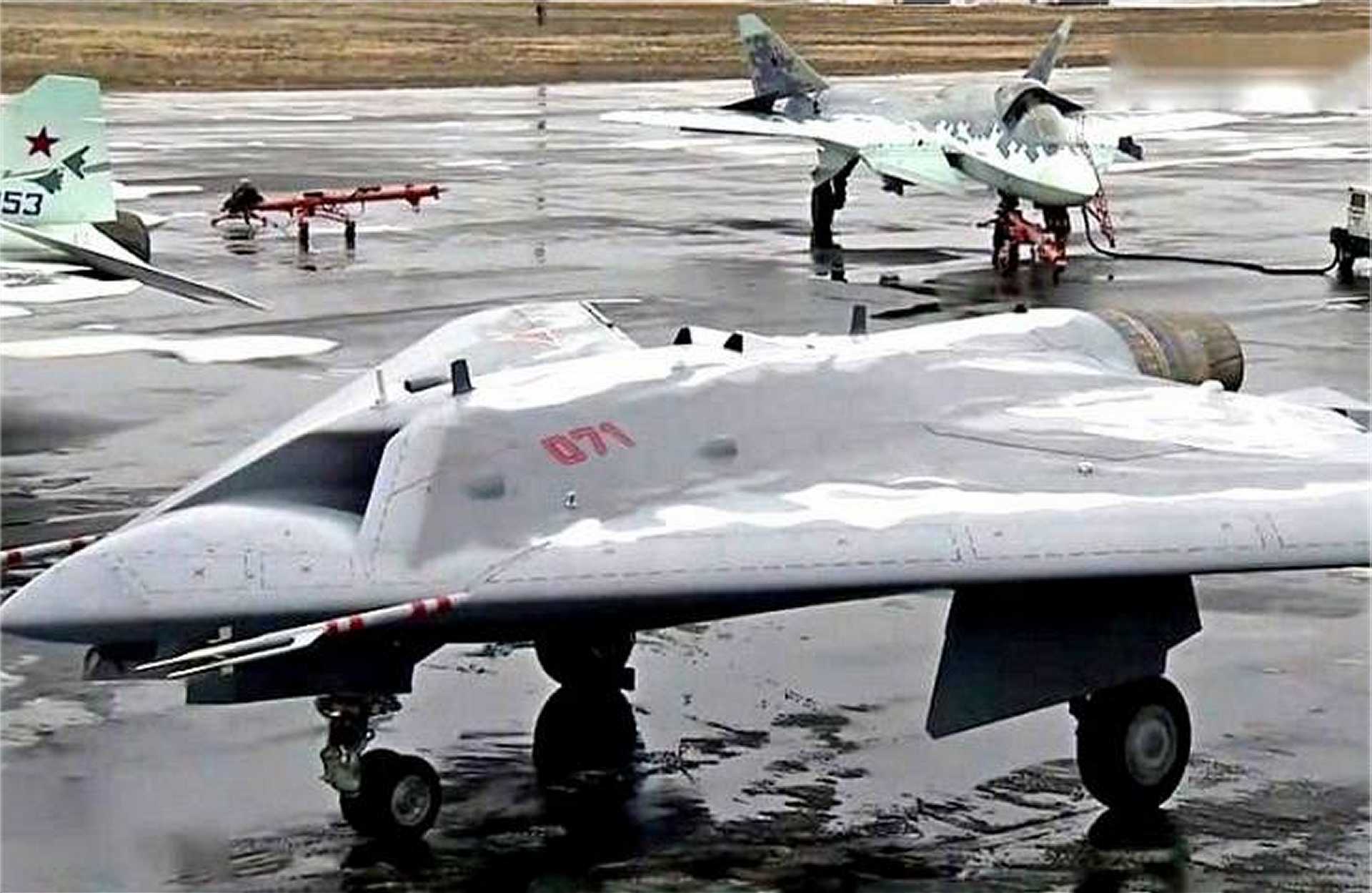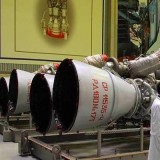Exclusive: Russia Ready To Deploy Okhotnik stealth drone with Su-57 fighter jet in new manned-unmanned strike strategy

{loadposition bannertop}
{loadposition sidebarpub}
Citing recent information from Yuri Koptev, Managing Director of Russian State Defense Company, ROSTEC, the Russian defense aerospace industry continues to make significant strides in developing advanced unmanned aerial capabilities with the S-70 Okhotnik-B, a large strategic stealth drone engineered to operate in direct coordination with the Su-57 fifth-generation fighter jet. This innovative manned-unmanned teaming concept is set to redefine Russia’s aerial warfare doctrine, with a strong emphasis on integrating autonomous systems into traditional combat formations.Follow Army Recognition on Google News at this link
The Russian S-70 Okhotnik stealth drone is positioned alongside the Su-57 fighter jet on the tarmac, highlighting the operational pairing of unmanned and manned platforms as part of Russia’s evolving air combat strategy. (Picture source: Russian TV)
Developed by Sukhoi in partnership with Russian Aircraft Corporation MiG, the S-70 Okhotnik-B — which translates to “Hunter” — embodies a stealthy flying-wing design similar to the American B-2 Spirit. It incorporates advanced composite materials and radar-absorbent coatings to reduce its radar cross-section and enhance survivability in contested environments. The drone is approximately 20 tons in weight and spans nearly 20 meters in wingspan. It is powered by an AL-31F turbofan engine, providing it with subsonic cruising speeds of up to 1,000 km/h and an operational ceiling of around 12,000 meters. With a combat radius of approximately 4,000 km, the Okhotnik can engage in deep-strike missions or long-endurance surveillance without the need for aerial refueling.
One of the defining features of the Okhotnik-B is its ability to carry munitions internally. This internal weapon bay allows it to remain stealthy while being armed with a range of precision-guided bombs and missiles. Its sensor suite includes advanced electro-optical systems, synthetic aperture radar, and signals intelligence capabilities, enabling it to execute reconnaissance, electronic warfare, and precision strike missions. These capabilities make it not only a valuable strike asset but also a critical node in a networked battlespace.
What sets the Okhotnik-B drone apart is its interoperability with the Su-57 multirole stealth fighter. The concept of pairing a manned fighter with multiple unmanned wingmen significantly expands the combat effectiveness of Russia’s air force. The Su-57 can act as a command node, directing the drones to scout ahead, conduct electronic jamming, or engage targets in high-threat areas without endangering the pilot. This pairing allows Russian forces to project power deeper into contested zones while reducing risk to manned assets.
According to reports, a two-seat variant of the Su-57 is being developed specifically to command and control up to four Okhotnik drones simultaneously. This capability enables highly coordinated operations involving swarming tactics, saturation strikes, and real-time intelligence sharing. By using the drones as decoys, jammers, or strike elements, the Su-57 pilot can maintain a safe standoff distance while shaping the battlespace.
The Okhotnik program has already achieved several operational milestones. The first flight took place in August 2019, with a landmark joint flight with the Su-57 occurring shortly thereafter in September 2019. Subsequent testing has included simulated missile engagements and advanced fire-control assessments. However, the program has faced setbacks, including a high-profile incident in October 2024, when a Russian Su-57 reportedly downed its own Okhotnik drone over Ukraine to prevent the sensitive technology from falling into enemy hands. Despite this, Ukrainian forces were said to have recovered parts of the drone, potentially allowing Western analysts to study its systems.
The deployment of unmanned wingmen alongside fighter aircraft is not unique to Russia. Other nations, particularly the United States and China, are also pursuing similar concepts. The U.S. has been developing loyal wingman drones such as the Boeing MQ-28 Ghost Bat (formerly known as the Airpower Teaming System), designed to support F-35 and F-22 fighters. These drones aim to conduct autonomous missions, act as force multipliers, and reduce pilot workload in high-intensity operations. China has also showcased its FH-97A loyal wingman drone at airshows, signaling interest in similar capabilities.
The advantages of such systems are manifold. They enable force multiplication, allow human pilots to stay out of high-risk zones, and offer increased flexibility in mission planning. Drones can be equipped with specialized payloads — such as electronic warfare modules, decoys, or long-range missiles — tailored for specific operational roles. Additionally, the use of AI-assisted control systems promises faster reaction times and reduced decision-making burdens on manned aircraft pilots.
Russia’s S-70 Okhotnik-B represents a significant leap toward integrating unmanned systems into its tactical and strategic air forces. While the program is still undergoing refinement and testing, its eventual integration with the Su-57 points to a future where coordinated manned-unmanned operations become the norm. If successful, the Okhotnik could serve as a model for future UCAV development globally, offering insight into the evolving nature of air power in the 21st century.

{loadposition bannertop}
{loadposition sidebarpub}
Citing recent information from Yuri Koptev, Managing Director of Russian State Defense Company, ROSTEC, the Russian defense aerospace industry continues to make significant strides in developing advanced unmanned aerial capabilities with the S-70 Okhotnik-B, a large strategic stealth drone engineered to operate in direct coordination with the Su-57 fifth-generation fighter jet. This innovative manned-unmanned teaming concept is set to redefine Russia’s aerial warfare doctrine, with a strong emphasis on integrating autonomous systems into traditional combat formations.
Follow Army Recognition on Google News at this link
The Russian S-70 Okhotnik stealth drone is positioned alongside the Su-57 fighter jet on the tarmac, highlighting the operational pairing of unmanned and manned platforms as part of Russia’s evolving air combat strategy. (Picture source: Russian TV)
Developed by Sukhoi in partnership with Russian Aircraft Corporation MiG, the S-70 Okhotnik-B — which translates to “Hunter” — embodies a stealthy flying-wing design similar to the American B-2 Spirit. It incorporates advanced composite materials and radar-absorbent coatings to reduce its radar cross-section and enhance survivability in contested environments. The drone is approximately 20 tons in weight and spans nearly 20 meters in wingspan. It is powered by an AL-31F turbofan engine, providing it with subsonic cruising speeds of up to 1,000 km/h and an operational ceiling of around 12,000 meters. With a combat radius of approximately 4,000 km, the Okhotnik can engage in deep-strike missions or long-endurance surveillance without the need for aerial refueling.
One of the defining features of the Okhotnik-B is its ability to carry munitions internally. This internal weapon bay allows it to remain stealthy while being armed with a range of precision-guided bombs and missiles. Its sensor suite includes advanced electro-optical systems, synthetic aperture radar, and signals intelligence capabilities, enabling it to execute reconnaissance, electronic warfare, and precision strike missions. These capabilities make it not only a valuable strike asset but also a critical node in a networked battlespace.
What sets the Okhotnik-B drone apart is its interoperability with the Su-57 multirole stealth fighter. The concept of pairing a manned fighter with multiple unmanned wingmen significantly expands the combat effectiveness of Russia’s air force. The Su-57 can act as a command node, directing the drones to scout ahead, conduct electronic jamming, or engage targets in high-threat areas without endangering the pilot. This pairing allows Russian forces to project power deeper into contested zones while reducing risk to manned assets.
According to reports, a two-seat variant of the Su-57 is being developed specifically to command and control up to four Okhotnik drones simultaneously. This capability enables highly coordinated operations involving swarming tactics, saturation strikes, and real-time intelligence sharing. By using the drones as decoys, jammers, or strike elements, the Su-57 pilot can maintain a safe standoff distance while shaping the battlespace.
The Okhotnik program has already achieved several operational milestones. The first flight took place in August 2019, with a landmark joint flight with the Su-57 occurring shortly thereafter in September 2019. Subsequent testing has included simulated missile engagements and advanced fire-control assessments. However, the program has faced setbacks, including a high-profile incident in October 2024, when a Russian Su-57 reportedly downed its own Okhotnik drone over Ukraine to prevent the sensitive technology from falling into enemy hands. Despite this, Ukrainian forces were said to have recovered parts of the drone, potentially allowing Western analysts to study its systems.
The deployment of unmanned wingmen alongside fighter aircraft is not unique to Russia. Other nations, particularly the United States and China, are also pursuing similar concepts. The U.S. has been developing loyal wingman drones such as the Boeing MQ-28 Ghost Bat (formerly known as the Airpower Teaming System), designed to support F-35 and F-22 fighters. These drones aim to conduct autonomous missions, act as force multipliers, and reduce pilot workload in high-intensity operations. China has also showcased its FH-97A loyal wingman drone at airshows, signaling interest in similar capabilities.
The advantages of such systems are manifold. They enable force multiplication, allow human pilots to stay out of high-risk zones, and offer increased flexibility in mission planning. Drones can be equipped with specialized payloads — such as electronic warfare modules, decoys, or long-range missiles — tailored for specific operational roles. Additionally, the use of AI-assisted control systems promises faster reaction times and reduced decision-making burdens on manned aircraft pilots.
Russia’s S-70 Okhotnik-B represents a significant leap toward integrating unmanned systems into its tactical and strategic air forces. While the program is still undergoing refinement and testing, its eventual integration with the Su-57 points to a future where coordinated manned-unmanned operations become the norm. If successful, the Okhotnik could serve as a model for future UCAV development globally, offering insight into the evolving nature of air power in the 21st century.





